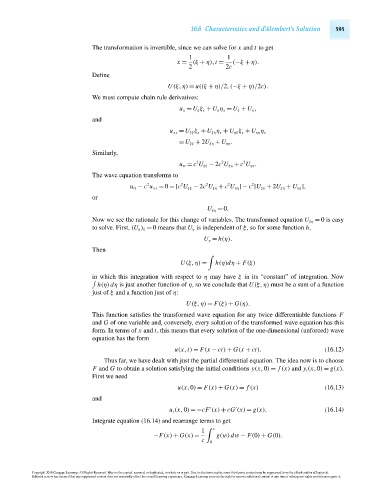Page 615 - Advanced_Engineering_Mathematics o'neil
P. 615
16.6 Characteristics and d’Alembert’s Solution 595
The transformation is invertible, since we can solve for x and t to get
1 1
x = (ξ + η),t = (−ξ + η).
2 2c
Define
U(ξ,η) = u((ξ + η)/2,(−ξ + η)/2c).
We must compute chain rule derivatives:
u x = U ξ ξ x + U η η x = U ξ + U η ,
and
u xx = U ξξ ξ x + U ξη η x + U ηξ ξ x + U ηη η x
= U ξξ + 2U ξη + U ηη .
Similarly,
2
2
2
u tt = c U ξξ − 2c U ξη + c U ηη .
The wave equation transforms to
2
2
2
2
2
u tt − c u xx = 0 =[c U ξξ − 2c U ξη + c U ηη ]− c [U ξξ + 2U ξη + U ηη ],
or
U ξη = 0.
Now we see the rationale for this change of variables. The transformed equation U ξη = 0 is easy
to solve. First, (U η ) ξ = 0 means that U η is independent of ξ, so for some function h,
U η = h(η).
Then
U(ξ,η) = h(η)dη + F(ξ)
in which this integration with respect to η may have ξ in its “constant” of integration. Now
h(η)dη is just another function of η, so we conclude that U(ξ,η) must be a sum of a function
just of ξ and a function just of η:
U(ξ,η) = F(ξ) + G(η).
This function satisfies the transformed wave equation for any twice differentiable functions F
and G of one variable and, conversely, every solution of the transformed wave equation has this
form. In terms of x and t, this means that every solution of the one-dimensional (unforced) wave
equation has the form
u(x,t) = F(x − ct) + G(x + ct). (16.12)
Thus far, we have dealt with just the partial differential equation. The idea now is to choose
F and G to obtain a solution satisfying the initial conditions y(x,0) = f (x) and y t (x,0) = g(x).
First we need
u(x,0) = F(x) + G(x) = f (x) (16.13)
and
u t (x,0) =−cF (x) + cG (x) = g(x). (16.14)
Integrate equation (16.14) and rearrange terms to get
1 x
−F(x) + G(x) = g(w)dw − F(0) + G(0).
c 0
Copyright 2010 Cengage Learning. All Rights Reserved. May not be copied, scanned, or duplicated, in whole or in part. Due to electronic rights, some third party content may be suppressed from the eBook and/or eChapter(s).
Editorial review has deemed that any suppressed content does not materially affect the overall learning experience. Cengage Learning reserves the right to remove additional content at any time if subsequent rights restrictions require it.
October 14, 2010 15:23 THM/NEIL Page-595 27410_16_ch16_p563-610

